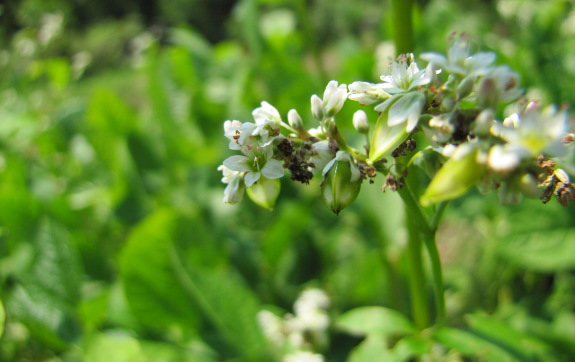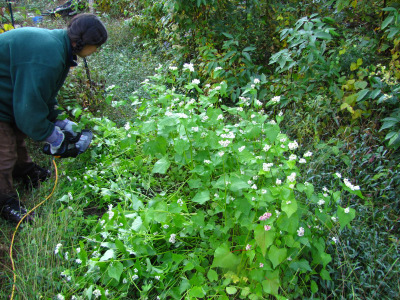
How can you mow a cover crop then plant into it?
 "I'm confused about rye and
buckwheat. I have used them before and tilled them in, but, with the
no-till method, how does just cutting them down allow you to plant
something else in their place? Would the cut areas not resemble cut
grass (for the rye) with the root mass still present? How do you plant
in this?"
"I'm confused about rye and
buckwheat. I have used them before and tilled them in, but, with the
no-till method, how does just cutting them down allow you to plant
something else in their place? Would the cut areas not resemble cut
grass (for the rye) with the root mass still present? How do you plant
in this?"--- Heather W.
 Even though I've written an
entire ebook on the
subject, I still get this question quite a bit, so I thought I'd answer
it in a post. The trick with mow-killing cover crops is to
understand the plants' life cycle. Lawn grasses are perennials,
but the cover crops I'm writing about are all annuals, meaning that
they sprout, grow for a while, then bloom and push all their energy
into a seed. After blooming, annuals naturally die and leave the
ground bare for whoever comes next.
Even though I've written an
entire ebook on the
subject, I still get this question quite a bit, so I thought I'd answer
it in a post. The trick with mow-killing cover crops is to
understand the plants' life cycle. Lawn grasses are perennials,
but the cover crops I'm writing about are all annuals, meaning that
they sprout, grow for a while, then bloom and push all their energy
into a seed. After blooming, annuals naturally die and leave the
ground bare for whoever comes next.
While you can wait for
these annual cover crops to go to seed and perish on their own, you'll
then end up with a weed problem in your garden. Instead, I
recommend mow-killing when cover crops have just reached full bloom, at
which point the plants are totally committed to the reproductive
process. Plants that mow-kill easily will die if cut at full
bloom, rather than regrowing like a lawn grass would. You'll
still have a lot of root stubble, which I recommend topdressing with a
healthy dose of compost and letting sit for a few weeks (for rye) so
that microorganisms will turn the roots into humus. After that,
the ground will be bare and ready to plant into. (Buckwheat is so
succulent that you can plant into the
stubble nearly immediately.)
 Not
all annuals mow-kill readily, of course, and if you don't pay attention
to their life cycle, your mow-kill attempt will also fail. For
example, many of the annual grains will respond like lawn grasses if
you mow them when they're young and in a vegetative growth stage.
And, of course, you shouldn't expect mow-killing to work on perennial
cover crops. I haven't tried all these myself, but Managing
Cover Crops Profitably reports you'll have good
results mow-killing the following cover crops: annual ryegrass, barley,
rye, buckwheat, oilseed radishes, cowpeas (although my
experience differed),
field peas, hairy vetch, and woollypod vetch. Finally, if you
plan to mow-kill and it fails, there's always kill
mulches.
Not
all annuals mow-kill readily, of course, and if you don't pay attention
to their life cycle, your mow-kill attempt will also fail. For
example, many of the annual grains will respond like lawn grasses if
you mow them when they're young and in a vegetative growth stage.
And, of course, you shouldn't expect mow-killing to work on perennial
cover crops. I haven't tried all these myself, but Managing
Cover Crops Profitably reports you'll have good
results mow-killing the following cover crops: annual ryegrass, barley,
rye, buckwheat, oilseed radishes, cowpeas (although my
experience differed),
field peas, hairy vetch, and woollypod vetch. Finally, if you
plan to mow-kill and it fails, there's always kill
mulches.
For more information on
integrating cover crops into a no-till garden, check out Homegrown
Humus, only 99 cents
on Amazon.
Want more in-depth information? Browse through our books.
Or explore more posts by date or by subject.
About us: Anna Hess and Mark Hamilton spent over a decade living self-sufficiently in the mountains of Virginia before moving north to start over from scratch in the foothills of Ohio. They've experimented with permaculture, no-till gardening, trailersteading, home-based microbusinesses and much more, writing about their adventures in both blogs and books.
Want to be notified when new comments are posted on this page? Click on the RSS button after you add a comment to subscribe to the comment feed, or simply check the box beside "email replies to me" while writing your comment.

I have some land that has a high sand content and low organic content. It was previously planted with rotations of corn and soy with round-up sprayed. Can I use a cover crop and let it grow tto seed, replant itself and then mow to improve organic content on the second growth?
Is there a better method to increase soil quality? I will be converting to pasture and garden after allowing the ground-up to degrade.